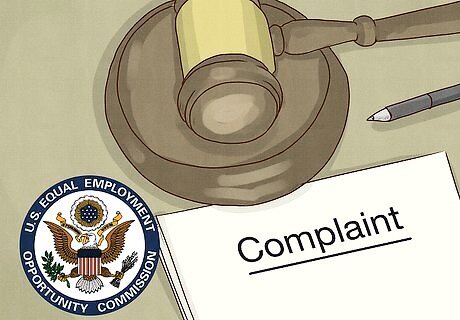
views
Dealing with Your Harasser

Consider your situation. Separate your emotions from the facts and think about your harasser. Is this a personality conflict? Does your behavior contribute anything to this situation? Be sure you are, in fact, dealing with a harassment situation before proceeding with further action. Workplace harassment is defined as, "unwelcome conduct that is based on race, color, religion, sex (including pregnancy), national origin, age (40 or older), disability or genetic information. Harassment becomes unlawful where 1) enduring the offensive conduct becomes a condition of continued employment, or 2) the conduct is severe or pervasive enough to create a work environment that a reasonable person would consider intimidating, hostile, or abusive." Remember that a workplace is a professional environment. People may not always be nice when they ask you to get work done or when they offer criticism on a project. While that may not be great workplace etiquette, it is not harassment. If you are experiencing ongoing threats, offensive jokes, physical assaults or threat of assault, slurs, mockery, putdowns, or interference with work performance, the behavior may be considered harassment. Isolated incidents are not usually considered harassment, but should be documented and reported as necessary. For example, a comment on your work, such as “You did a terrible job on this project. I can’t believe we hired you,” is poorly conveyed but not harassment. Harassment would be insulting who you are as a person on an ongoing basis, for example, “Hardly surprising a dumb woman would screw this up.” You can learn more about workplace harassment here: https://www.eeoc.gov/laws/types/harassment.cfm

Document all incidents of harassment. Record every encounter you have with your harasser. Include date, time, and the nature of the encounter. Be sure to indicate any witnesses that may have seen the incident. For example, your harasser bullies you at a job site. You could record: “March 3, 11 AM: John tells me to ‘go back to my own country’ at Main Street project. Witnesses: Alice, Sam, and Jaime.” Make sure you record the incidents on a document that is not accessible to the harasser. For example, you may want to use your home computer, a password-protected file on your personal mobile phone, or on a paper you keep in your car. Having multiple copies is advisable. Use your documentation to provide evidence for your case against your harasser to your supervisor or human resources. It can also be helpful for you to go back over these documents a day or two later and decide if what you experienced was truly harassment. Ask any witnesses who saw the harassment to write their own perception of the encounter. You could say, “Marie, would you mind jotting down what you saw between Manuel and me in the hallway? Could you give me a copy of it when you’re done? I want to keep track of all of these incidents.”

Ignore the harasser. At first, you may wish to try to see if the harassment will stop if you ignore the person. It may help you prove your case that you are doing nothing to provoke the person. If the harasser starts to bother you, you may try pretending you didn’t hear them, walking away, or turning your back to the person. If the harasser does not get a reaction from you, they may not be encouraged to continue their behavior. Think about a child not getting a rise out of their sibling, and then stopping the annoying behavior. If the harasser starts bothering you in the break room, for example, you could leave, take your lunch and eat it at your desk. If they start bothering you while you’re working at your desk, you could put on a pair of noise-canceling headphones while they are harassing you.

Set limits. Confront your harasser and let them know their behavior is unacceptable. Be professional and firm. While it can be difficult, keep your emotions in check when you confront your harasser. They will likely use your emotions against you. Remain calm and firm. It may be helpful to you to rehearse what you say to your harasser beforehand. You could say, “Rick, talking to me like that is unacceptable. Please stop.” You could say, “Quit following me and saying offensive things to provoke me. Your behavior is inappropriate in any setting, but especially in an office.” If possible, walk away from the harasser after you state your objection to their behavior. Do not allow them to draw you into a discussion about the behavior. You can simply state, "I've said all that I wish to say" and walk away or put on headphones.

Avoid being alone with the harasser. Make sure you are always around other people who can witness the harasser’s behavior. Ask your supervisor for tasks that don’t require you to be alone with the harasser. Ask to be reassigned to a different team if necessary. You could say, “I have been having some ongoing conflicts with Spencer. I noticed that Steve’s team has an opening right now. Would it be possible for me to get reassigned?” If they follow you into a room in which you are alone, try to either leave or make sure the door remains wide open.

Ask your friends to stick up for you. Build a support network of friendly coworkers who can help protect you from the harassment as well as be witnesses to any incidents that may occur. Ask your coworkers to be alert for any incidents of harassment against others as well. You could say, “Debbie, would you mind sitting with me in the lunchroom today? If Casey says anything to me, I would like to have you witness the incident.” Ask coworkers to stand up against the harasser on your behalf. You could say, “Tom, if you hear Jenny telling racist jokes around me again, can you please ask her to stop?”

Take care of yourself outside of work. Find ways to manage your stress and emotions in healthy ways when you off the clock. Try not to let your work life bleed into your personal life. Eat well, sleep well, and exercise. Staying physically healthy will benefit your mental health. Do activities you enjoy that help you feel good about yourself and destress. Spend time with caring family and friends. Try journaling about your feelings. This can be an excellent way to process your thoughts and emotions and brainstorm about possible solutions. You could even write exactly what you'd like to say to your harasser. Consider counseling to help you deal with difficult emotions and trauma that you may be experiencing in the face of your harassment.
Talking to Your Supervisor or Human Resources

Educate yourself on your rights and workplace protocol. Before addressing your concerns with your supervisor or at a higher level in your organization, take the time to familiarize yourself with the rules, policies, and procedures in place. Come into meetings with higher-ups informed and ready to advocate for yourself. Read over your employee manual, union materials (if you are represented by a union), and employment laws in your state and country. You may wish to consult an attorney or anyone you know who works in human resources. They should be well-versed on your rights in this area and may help you decide how to proceed. Bring copies of pertinent policies to share with your supervisor or other management.

Approach your supervisor first. Follow the appropriate chain of command in your organization. Ask to speak to your supervisor privately and in person about your concern. You could say, “Jim, do you have time to meet this afternoon? I have something I need to discuss with you privately.” Tell your supervisor about your problem and ask how they will address the situation. You could say, “What will you do to solve this problem with Melanie? Please follow up with me when you’ve taken action. If I don’t hear from you in a few days, I am going to follow up with you about it again.” Show your supervisor a copy of your harassment record. If your harasser is your supervisor, go to their supervisor. If you have a human resources representative, you may also wish to talk to them first instead.

Take your concerns to your human resources representative. You may choose to take your concerns to human resources, if your employer has a designated department. You may also feel more comfortable talking to human resources instead of your supervisor. Be sure you follow your company’s protocol, unless there are extenuating circumstances that prevent you from following it (for example, your boss is harassing you). Your HR rep will likely begin by meeting with you confidentially. They may provide you with coping strategies and suggestions for handling the harassment. Describe the situation to your HR rep, making sure you provide a written record of all of the documented instances of harassment. You could say, “For the past few weeks, Bob White in IT has started insulting me whenever he sees me. I started to make a list of all the incidents. I believe his behavior meets the definition of harassment.” Make a list of any questions you might have and bring them to the meeting. This meeting can be emotional and you may be nervous and forget everything you want to say. Bringing a list of what you'd like to address during the meeting can help ensure that all your questions are answered. Depending on the severity of what you have described, the HR rep may be compelled by law to open an investigation. If not, they may offer to meet with your harasser alone or with you present.
Taking the Next Steps

File a complaint. If you do not feel your employer has resolved this issue to your satisfaction, and you believe your harassment is discriminatory in nature, you can file a complaint (called a Charge of Discrimination) with the Equal Employment Opportunity Commission (EEOC) if you live in the United States. You must file your report within certain time limits, depending on the state in which you live and the nature of your complaint. The EEOC may investigate your complaint and suggest you begin a mediation process to solve the problem with your employer. The EEOC may open a formal investigation of your complaint. Depending on the nature of your complaint and federal, state, and local laws, they may find that you have the right to sue your employer for discrimination. They may also attempt to work toward a settlement with your employer on your behalf. The EEOC may not find your employer to be in violation of any laws and may decline to intervene in your case.

Talk to your union representative. If you are represented by a union in your workplace, talk to your union representative about the union’s ability to stand up to your workplace harassment with you. The union’s obligation and protocol will be spelled out in your union and employer’s collective bargaining agreement. Your union can help you demand that your employer take action to protect you from harassment, as well as help you protect yourself from the harasser. The union can help you file a grievance with your employer if your harasser is in management. If the harasser is a fellow union member, the union can help investigate the harassment, warn the harasser to stop, and/or file a grievance on your behalf to management for their failure to deal with the problem.

Hire an attorney. You may wish to contact an attorney who specializes in employment law who can help you figure out what steps you would like to take against your employer. The attorney could provide a consultation that will help you determine if you have a case, as well as the type of action you would like to take against your employer. Ask family or friends for attorney recommendations, or look online for attorneys near you. Meet with a few to determine the best fit for your needs and budget.

Look for another job. You may wish to look for another job if your work environment does not improve after repeated conversations with your supervisors and/or your employer’s human resources department. Staying in a stressful harassment situation can damage your mental and physical health. Ask your employer for a positive recommendation. You could say, “As I followed appropriate workplace protocol for reporting this harassment, and continued to complete my work successfully in spite of a difficult work environment, I would appreciate a positive letter of recommendation and reference for my next employer.” Avoid mentioning the harassment when interviewing with prospective employers. While it is unfair, you may be seen as a difficult employee if you have brought charges of harassment to the attention of your previous employer. If you are asked in an interview why you are leaving your current position, you could say, “I’m looking for new challenges and see this position as an opportunity for my professional growth.” If you suspect your former employer is giving you a bad recommendation, you may be able to do damage control. You can call HR at your old company and explain that you feel your boss is retaliating after your claims of harassment. Many companies now have policies about references — simply confirming that you worked there and the dates of employment — as bad references can sometimes lead to lawsuits. You can also send a "cease and desist" letter to the CEO or HR department stating the name of the person who gave the bad reference, suggesting they simply confirm your title and dates of employment. They may fear that you are going to pursue legal action and the behavior will most likely stop.




















Comments
0 comment